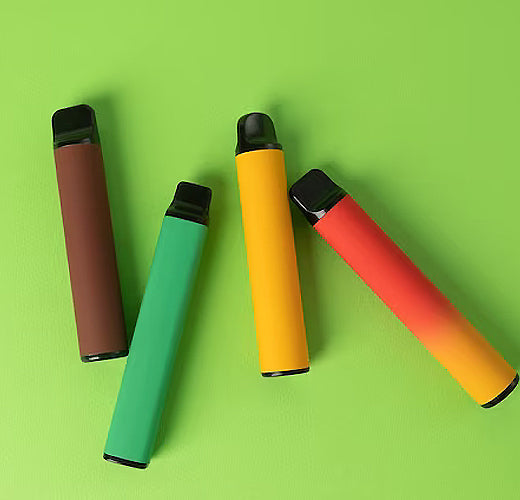
Share
Deciphering Nicotine Levels in Disposable Vapes
The topic of nicotine concentration is crucial to fully grasp the vaping experience. In this article, we will delve into the meaning of nicotine concentrations in disposable vapes and how to select the appropriate strength.
Why Nicotine Concentration Matters
Nicotine concentration in disposable vapes and other vaping products is of paramount importance due to its direct influence on the experience, addiction potential, and user health. The concentration level determines the strength of the nicotine hit, impacting satisfaction and cravings. It also plays a crucial role in the risk of addiction, with higher concentrations having a greater potential for habit-forming.
Furthermore, excessive nicotine intake, especially in high concentrations, can lead to immediate health concerns and potential long-term cardiovascular risks. Thus, selecting an appropriate nicotine concentration is essential for balancing enjoyment, addiction management, and overall well-being in vaping.
Nicotine Concentration Terminology
Nicotine concentration terminology in the context of vaping refers to the measurement of the amount of nicotine present in e-liquids or vape products, typically expressed in milligrams per milliliter (mg/ml). It encompasses a range of options, including low (3 mg/ml or less), medium (6-12 mg/ml), and high (above 18 mg/ml) concentrations. These levels cater to diverse user preferences, with lower concentrations suitable for casual or new users, medium concentrations appealing to those transitioning from smoking, and high concentrations chosen by heavy smokers seeking a stronger nicotine hit. Understanding and selecting the appropriate nicotine concentration is crucial for tailoring the vaping experience to individual needs and managing the risks associated with nicotine consumption.
Factors to Consider When Choosing Nicotine Concentration
When selecting the right nicotine concentration for vaping, several key factors must be considered. First, individual tolerance and nicotine dependence play a significant role; heavy smokers may require higher concentrations, while those looking to reduce nicotine intake should opt for lower levels.
Second, the desired vaping experience matters, as higher concentrations deliver a stronger throat hit and faster nicotine delivery, which can be satisfying for some users but overwhelming for others. Third, health considerations are essential, with higher concentrations posing a greater risk of addiction and potential adverse health effects.
Lastly, personal goals, such as quitting smoking or maintaining controlled nicotine consumption, should guide the choice of nicotine concentration, ensuring that it aligns with one's specific needs and preferences.
Matching Nicotine Concentration to Vaping Goals
Matching nicotine concentration to vaping goals is crucial for a tailored and effective experience. Users seeking to quit smoking or gradually reduce nicotine intake should opt for lower concentrations, such as 3-6 mg/ml, to minimize cravings and dependence. Those transitioning from smoking may find medium concentrations (6-12 mg/ml) suitable for a balanced experience.
In contrast, heavy smokers or those who prioritize a strong nicotine hit may choose higher concentrations, though they should be cautious of addiction risks and potential health effects. Ultimately, aligning nicotine concentration with vaping objectives is essential for achieving desired outcomes while promoting overall well-being.
Transitioning from Smoking to Vaping
Transitioning from smoking to vaping involves switching from traditional cigarettes to electronic cigarettes or vape devices as a harm-reduction strategy. It can be an effective way to reduce exposure to harmful tobacco smoke toxins. Successful transition often requires selecting an appropriate nicotine concentration in e-liquids to satisfy cravings, finding a vaping device that suits individual preferences, and seeking support to manage the behavioral and psychological aspects of quitting smoking.
Overall, this transition can offer a less harmful alternative for those looking to break free from the health risks associated with combustible tobacco products.
Avoiding Nicotine Overconsumption
Avoiding nicotine overconsumption is crucial for safe and responsible vaping. It involves selecting an e-liquid with an appropriate nicotine concentration that matches individual tolerance and goals. Beginners and those not heavily dependent on nicotine should start with lower concentrations, typically 3-6 mg/ml, to minimize the risk of addiction and adverse effects.
Regular monitoring of nicotine intake and seeking professional guidance when needed are essential to maintain control and ensure a safer vaping experience. Understanding one's limits and adjusting nicotine concentration accordingly is key to avoiding excessive consumption and its associated health risks.
Experimenting and Finding the Right Balance
Experimenting and finding the right balance in vaping involves exploring various nicotine concentrations and vaping styles to tailor the experience to individual preferences and needs. It may require trying different e-liquids with varying nicotine levels and adjusting the choice based on cravings, satisfaction, and overall enjoyment. This process empowers users to strike a balance between nicotine intake, vaping satisfaction, and health concerns, ensuring that the chosen nicotine concentration aligns with their goals and promotes a responsible and enjoyable vaping experience.
Understanding Nicotine Salt E-Liquids
Understanding nicotine salt e-liquids involves recognizing that they contain a different form of nicotine compared to traditional e-liquids. Nicotine salts provide a smoother throat hit and quicker nicotine absorption, making them suitable for high-nicotine vaping while maintaining a less harsh experience.
Users interested in a more cigarette-like sensation or those transitioning from smoking may find nicotine salt e-liquids beneficial, but it's crucial to exercise caution and choose the appropriate concentration to prevent excessive nicotine consumption and potential health risks.
Seeking Professional Advice
Seeking professional advice for nicotine addiction is a crucial step for individuals struggling to control their nicotine consumption, whether through smoking or vaping. This process involves consulting healthcare providers or addiction specialists who can offer tailored guidance and support to address addiction challenges. Professionals can provide evidence-based treatments, behavioral therapies, and counseling to help individuals overcome their addiction. Seeking expert advice is essential for managing nicotine addiction effectively and improving overall well-being.
Conclusion
In conclusion, understanding nicotine concentrations is pivotal for a safe and personalized vaping experience. It empowers users to make informed choices that align with their preferences, vaping goals, and nicotine tolerance. By selecting the right concentration, individuals can enjoy vaping while minimizing addiction risks and potential health effects, ensuring a responsible and satisfying journey in the world of vaping.
